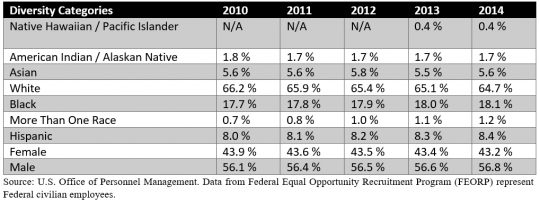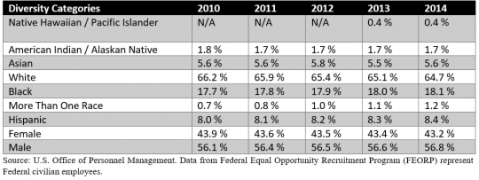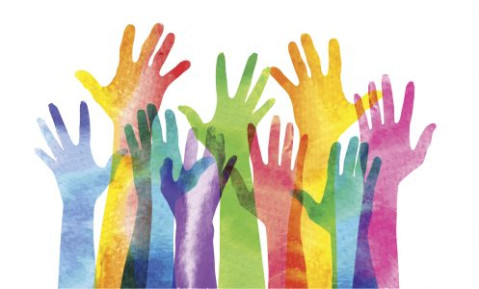Widgetized Section
Go to Admin » Appearance » Widgets » and move Gabfire Widget: Social into that MastheadOverlay zone
When Money Can’t “Buy” Diversity: Experience of Google and the U.S. Department of State
The views expressed are those of the author and do not necessarily reflect the views of ASPA as an organization.
By Nkechi Onwuameze
August 10, 2018

The assumption that diversity can’t be achieved without money is not only false, but also is a dangerous assumption to hold. Both in the public and private sectors, employers spend millions of dollars on diversity initiatives, including spending resources on diversity training, creating offices of equal employment, hiring Chief Diversity Officers and implementing new hiring strategies to increase minority employees. In fact, there is hardly any organization that does not have “improving diversity” as its key goal—and yet, they fail repeatedly, both private and public. While employers have become savvy in effectively communicating their diversity goals, they shrink from addressing why the targeted minority employees seem untouched by the vast diversity initiatives. To shy away from addressing the widely known evidence that minority groups feel less valued and alienated at the various institutions—school, workplace, government—is sweeping the problem under the carpet and risking perpetuating the intergenerational effects of marginalization that money alone can’t fix.
Google and the U.S. Department of State have been chosen for this illustration because of some of their innovative approach to improving diversity as well as the resources they commit to achieving that. Following public pressure for technology employers to address the lack of diversity in the industry, in 2014, Google took the lead and invested millions of dollars to improve workforce diversity. In an interview with Time Magazine in 2015, former Google’s Vice President for diversity, Nancy Lee detailed plans to increase the spending on diversity initiatives from $115 million to $150 million, a whopping $265 million in two years, yet the latest 2018 diversity Annual Report shows the attrition rates remain the highest for Black Google employees and only 2 percent of Google employees were Black compared to 56.6 percent who were White and 24.5 percent who were female. The report states that “Black Googler attrition rates, while improving in recent years, have offset some of our hiring gains, which has led to smaller increases in representation than we would have seen otherwise.”
Google’s own assessment of this failure indicate more work need to be done beyond using money. The report acknowledges that an inclusive workplace increases retention of minority workers and “to improve workforce representation we must focus not only on hiring, but also on developing, progressing, and retaining members of underrepresented employees, and creating an inclusive culture.”
In the public sector, the tale is similar as increasingly the focus seems to be on how the allocated diversity funds can “purchase” diversity rather than how to achieve an inclusive workforce where every employee feel valued. The data on federal government workforce (see Table 1 below) show there’s slow progress in achieving a diverse workforce despite the increase in spending for federal diversity initiatives.

Table 1. Racial and Gender Representation in Federal Workforce
Achieving workforce diversity is a key goal of the U.S. Department of State. This goal is reflected in the State Department’s Bureau of Human Resources mission statement which is “to recruit, retain, sustain, and empower a diverse, talented workforce to carry out the Department’s foreign policy goals and priorities.” The Department of State plans for diversity is a requirement in Public Law 113–499, specifying that the Committee on Appropriations “supports the commitment of the Department of State to increase diversity in hiring, retention, and promotion and has included sufficient funding to continue and expand its recruitment programs for State Department diversity effort.” In fulfilling this mission, the HR department budgeted $5,375,000 to diversity recruitment initiatives, including $375,000 for diversity outreach (advertising contract and marketing). Despite these efforts, achieving diversity continues to be a challenge for the State Department as well as other federal agencies. The former Secretary of State, Rex Tillerson did not mince words when he admitted that “we have a great diversity gap in the State Department.” We need a State Department that reflects the American people, reflects who we are. The State Department must redouble our efforts to increase diversity at the highest ranks of the department.” Tillerson further said that only 12.5 percent of senior State Department staff are “non-white.” In Fiscal Year 2015, only 15.1 percent of Black Foreign and Civil Service employees were represented at the State Department, while 71.1 percent were White.
These two organizations cited here are examples of companies investing resources and doing some innovative work to achieve a diverse workforce but are yet to achieve the desired outcome. So the questions still remain, with all the efforts and resources on diversity initiatives, why is the progress slow? Why have the private and public sectors failed to achieve a diverse workforce? Perhaps, the missing untapped strategy lies in what money alone can’t buy- ensuring minority students, employees, managers, senior executives feel valued and part of the system.
Author: Nkechi Onwuameze works for the Illinois Board of Higher Education and an adjunct professor at the University of Illinois Springfield. She earned a Ph.D. in sociology of education at the University of Iowa. Her research interest include educational inequality, gender discrimination in the workplace, workplace diversity. [email protected] or Twitter: @Nkobis






Nkechi O.
August 17, 2018 at 12:16 am
Thanks June for the comment!
You’re right, low morale equals low productivity, then it becomes even riskier if the issues are never addressed and we wonder why we are not close to achieving our diversity goals.
Nkechi O.
August 17, 2018 at 12:02 am
Great point M. MacPherson! The role of internship is important in the diversity debate, but unfortunately often neglected and we keep wondering why the workplace is not diverse…
Thanks for your comment M. MacPherson
M. MacPherson
August 16, 2018 at 1:02 pm
Something overlooked is the role that internships play in hiring new employees. Those interns often come from particular “elite” schools not as likely to have minority and poor white, first generation, college students. The role of “legacy” in hiring (generations of diplomats) also plays a role.The foreign service test itself makes it difficult to get graduates from non-Ivy schools.
June Agamah
August 13, 2018 at 1:15 am
Thank you for this wonderful work of art. This subject of diversity in the workplace is indeed timely and deserving of attention. Being a valued consumer works even in the workplace. When employees feel a sense of belonging, employers can rest assure that the work environment will be wonderful and production will increase. When low morale is present, everyone looses.